May 11, 2022 - March 1, 2023
Curators
Anne Bissonnette, PhD, Emma Carr, BA, Josée Chartrand, MA, and Qi Wang, BA
[De]Coded:
Deciphering the Dialects of Dress
ARTIFACTS IN THE EXHIBITION
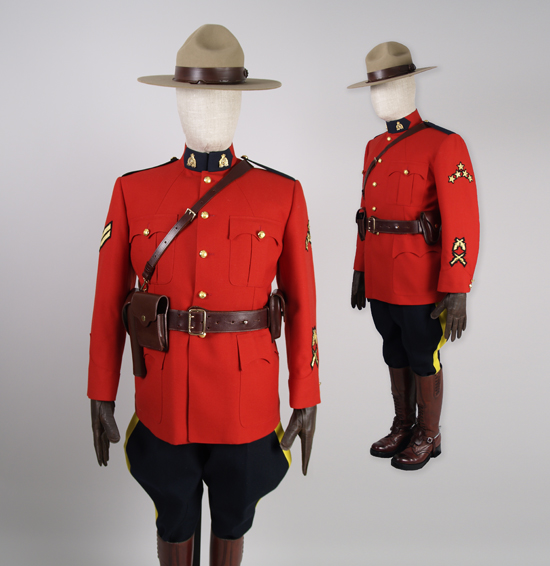
1
Royal Canadian Mounted Police Uniform (known as the “Red Serge”)
Worn in Sainte-Anne-des-Lacs, Québec, Canada, before 2016
Anne Lambert Clothing and Textiles Collection, 2017.2.1 a (wool jacket); b (wool pants); d, e (leather boots); f (wool & leather hat); g, h, q (leather gloves & holster belt); o, p (metal spurs).
Donated by Christiane Lemay
The North-West Mounted Police (1873-1920) preceded the RCMP. The organization aimed to address violent and illegal activities three years after Canada purchased the North-West Territories.[1] A 1950s author describes how red coats represented British traditions and principles.[2] The author believed that “to the Indian the red coat meant honesty, fairness, courage, square dealing.”[3] While the author presented a colonial perspective, the sight of the “Mountie” may have been reassuring to some as they walked a fine line between governmental mandates and sincere community service.

2
Red Printed Ribbon Dress
Cotton dress made by Janet Delorme in Edmonton, Alberta, Canada, before May 2021, worn by her to Congress in 2021
Loaned by Janet Delorme and the University of Alberta, Faculty of Native Studies
Worn with
Black Wood Bead Belt and Printed Cotton Shawl
Made by Janet Delorme in Edmonton Alberta, Canada, before May 2021, worn by her to Congress in 2021
Loaned by Janet Delorme and the University of Alberta, Faculty of Native Studies
|
Janet Delorme is Blackfoot from the Blood tribe, or Kainai Nation. She started with the Faculty of Native Studies in July 2018 as Front Desk Reception, but has previous experience working within the U of A over the past 20 years. She has over 15 years in an office environment and 10 years working as a bookkeeper. She enjoys working with people and learning new things each day. Below is a description of her making process in her own words.
The ribbon dress was part of an inspiration design for Congress 2021 held virtually by the University of Alberta in May 2021. The theme for Congress 2021 was “Northern Relations”. The concept of my creation was to represent Missing and Murdered Indigenous Women (MMIW). Depending on the part of Canada, the title could include Girls, Boys, Men, Two-spirited, and/or all genders. At this point with the theme and my concept I felt they were two different areas and did not include it in my overall project. But the ribbon dress was still made to represent MMIW overall. I want to share some background information on why I chose to work on a ribbon dress for MMIW. My older brother was murdered back in 1986 and there was no justice. I was very young when this happened, but it still is a very important part of my life growing up as it made me who I am today. Not only did it shape my way of thinking of how the justice system failed my family, but how Indigenous people are treated in Canada. Not to go deep into politics or get very personal, but sometimes we need to be presented with the truth in order to understand our path in life. Sometimes tragedies or pain can help you strive to be stronger or successful. Or it can go the other way and bring depression or bad things in life. For me it brought strength and I continue to help others. I am one of many family members from the Blood Tribe that had been meeting for many months to collaborate on the ribbon dress and provide a vision to others, especially non-indigenous people, and to bring awareness to MMIW. It has been difficult to provide insight to the creation of the ribbon dress, but it has also brought healing to hear others share their stories. As well as having time to grieve with them with many tears of sadness and disbelief. Upon hearing memories of our loved ones, there were fond happier times when they were here with us and their memories forever live within us. My ribbon dress represents MMIW through my eyes. The colour of red means strength, power, and awareness, as well as violence and blood. My design, colours, and material are heart shapes and red cloth with satin red and black ribbons. I chose hearts instead of the MMIW handprint. Indigenous people, especially in ceremony, connect to our mind, body, and spirit. The heart not only symbolizes the body, but connection to our loved ones. The black ribbon represents mourning and memories of the ones who passed on before us and our ancestors. The red ribbon represents love and womanhood as well as strength, power, awareness, and violence. I was taught from my mother that the ribbon dresses for Blackfoot peoples were very sacred and used for ceremonies or wearing in pow-wows such as regalia or to honour blessings and success. Other people were not allowed to touch your dress without permission. The traditional dresses were made from hide and in later years fabric and materials like wool, broadcloth, and silk. The front and back as well as along the edging were beaded and would consist of lines or curves. The dress would include fringes along the edges that were cut from the hide used. Some dresses had cowrie shells attached in a row as a straight edge design or v-curve. Going back further, some of the traditional dresses were made from elk teeth or called an Elk tooth dress, this was part of the crow nation as well as Blackfoot confederacy. This project and the ribbon dress I created are not only dear to me to represent my own family and friends that I lost due to being murdered or gone missing, but to make people understand that most people hold some sort of heartache or sadness within them. And to be kind to others because we just do not know what hardship or struggles others may have or had. Having the opportunity to showcase my gifted talent allows me to speak on my own tragedies to help me heal and give my inner spirit the release to bring in positive energy. Thank you so much for allowing me to share.
|
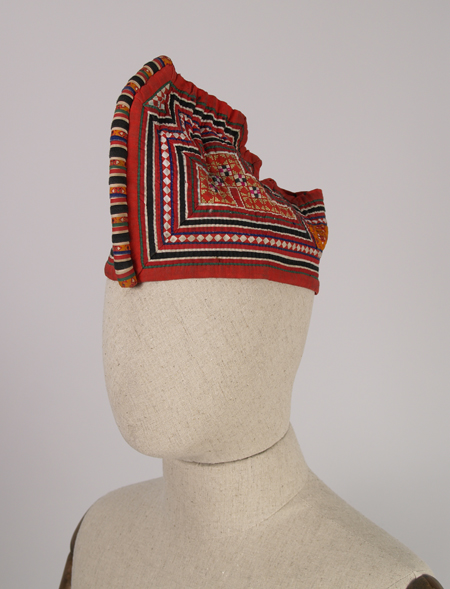
3
Multicoloured Hmong New Year's Hat
Thailand, ca. 1980-1987
Child’s cotton hat with appliqued embroidered motifs
Anne Lambert Clothing and Textiles Collection, 1987.9.7
Donated by Anne Lambert
The Hmong are an ethnic minority group in Thailand who maintain their traditional culture through language and dress. Children’s hats are an essential component of their culture. They may be embellished with abstract geometric embroidered patterns, which “Hmong could understand as a shared visual language within an oral culture.”[4] Other decorative treatments can include appliqué, coins, and pom-poms, the latter aiming to protect from evil spirits by disguising the child as a flower.[5]
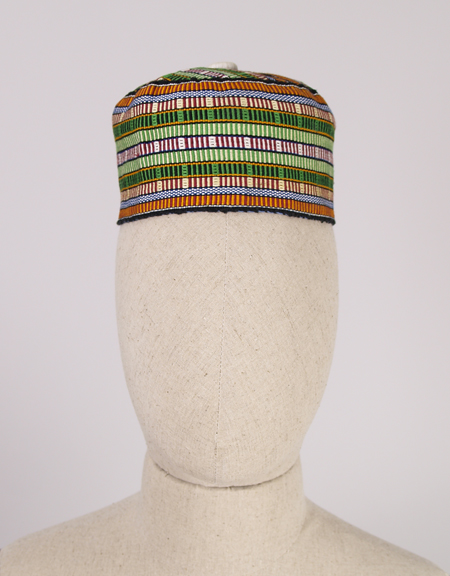
4
Multicoloured Cotton Skullcap
Ghana, ca. 1975
Cotton warp-faced band and cream-colored covered top
Anne Lambert Clothing and Textiles Collection, 1988.8.10
Donated by Lila Enberg

5
Saffron-coloured Sikh Turban
Likely from South Asia, ca. 1990
Cotton, pre-draped man’s turban
Anne Lambert Clothing and Textiles Collection, 1990.18.1
Donated by Susan Pointe
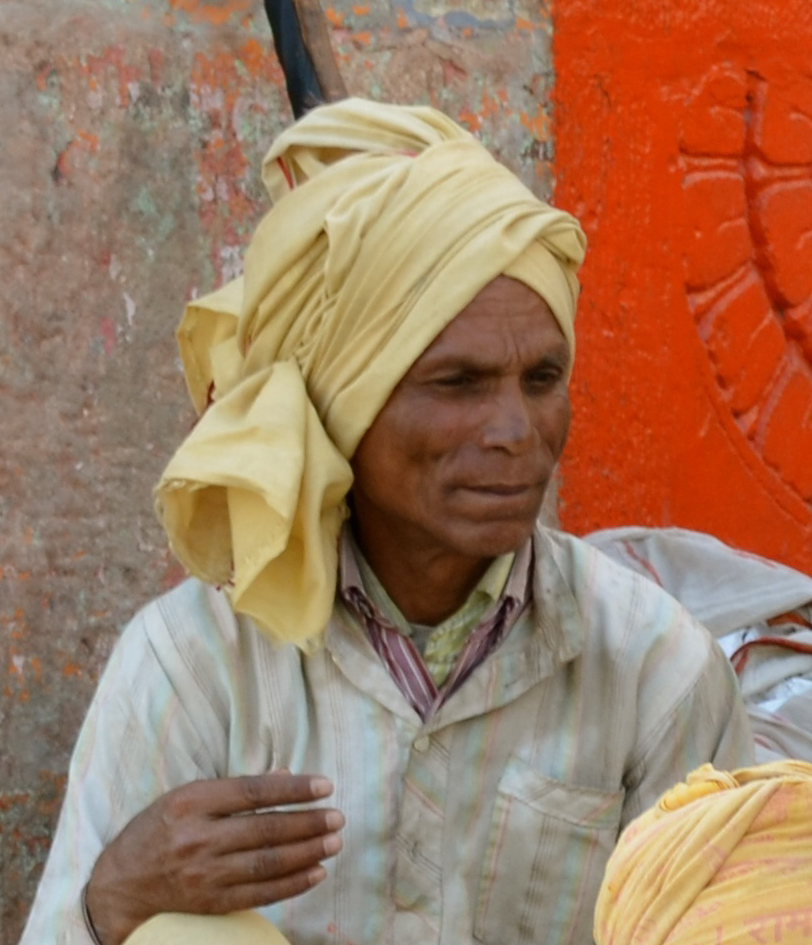
Photograph of a man in a turban, India
Josée Chartrand
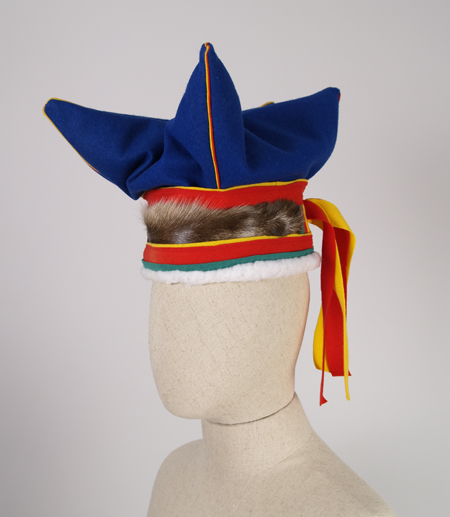
6
Blue Saami Hat
Finland, ca. 1960s
Men’s felted wool hat with four-point crown trimmed in yellow and red piping; fur and felt hatband with red, yellow, and green ribbons
Anne Lambert Clothing and Textiles Collection, 1990.15.45
Donated by Anne Lambert
Given to Leonard Lambert and/or his son Bernard, by a Finnish businessman. Leonard Lambert was Bombardier's distributor for Western Canada, and had traveled to Finland to attend a meeting in connection with the opening of a new distributorship in Finland.
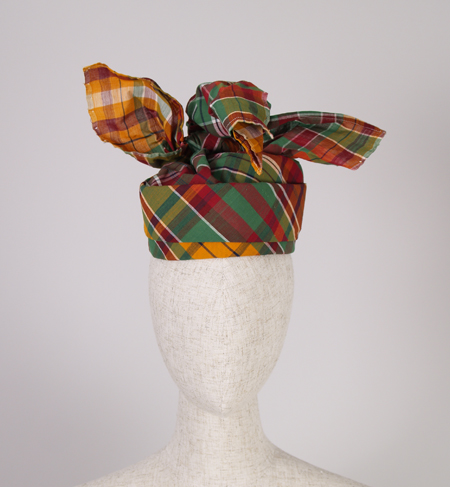
7
Multicoloured Tete Case Headdress
Made by Esma Jn. Marie in Saint Lucia, 1983
Cotton headdress worn by Sister Mary Gallagher and created specifically for a Mission Fair in Cincinnati, Ohio.
Anne Lambert Clothing and Textiles Collection, 1985.7.3
Donated by Janice Smith
Part of the Wobe Dwiyet (national costume of Saint Lucia), this square of Madras cloth is folded to suit “the romantic commitment of the person wearing it.”[6] Three peaks signal the wearer “is married and not available.”[7]

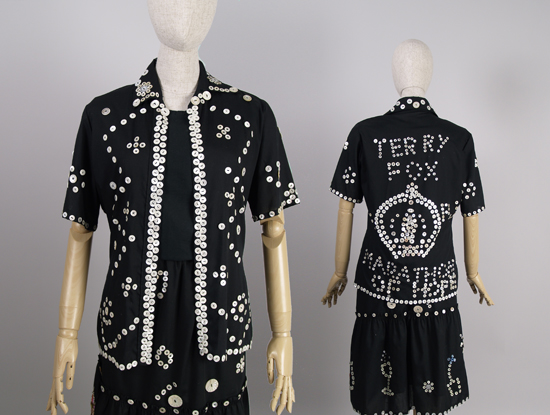
8
Black “Terry Fox Marathon” “Pearly Queen” Suit
Made by Thelma Chissell (British) and worn in Edmonton, Alberta, Canada, 1970s
Polyester embellished with mother-of-pearl buttons and the words “Terry Fox” and “Marathon of Hope”
Anne Lambert Clothing and Textiles Collection, 2012.4.9 (shirt) and 2012.4.7 b (skirt)
Donated by June (née Chissell) and Michael Dickerson

9
Black “Pearly King” Three-piece Suit
Made by Thelma Chissell (British) and worn by Tom Chissell in Edmonton, Alberta, Canada, 1970s
Polyester embellished with pins and mother-of-pearl buttons and the words “Pearly King”
Anne Lambert Clothing and Textiles Collection, 2012.4.2 a (jacket); b (pants); 1993.11.2 ab (shoes); bandana and shirt on loan from MacEwan University
Donated by June (née Chissell) and Michael Dickerson
Pearly kings and queens raise funds for charity in attire that draws from regional and occupational dress. The copious use of low-cost mother-of-pearl buttons was developed by Henry Croft (1862-1930), a man born in a Victorian workhouse orphanage in central London.[8] He expanded upon a practice by local costermongers (street traders). Dressed in “flash boy” outfits with a row of ornamental pearl buttons on their pants, costermongers believed in helping those in need, even when they had little to give.[9]
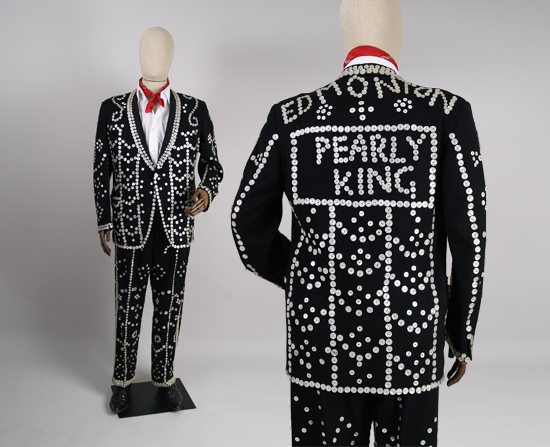
10
Black “Pearly King” Suit, Cap, and Tie
Made by Thelma Chissell (British) and worn by Tom Chissell in Edmonton, Alberta, Canada, 1970s
Polyester embellished with mother-of-pearl buttons and the words “Edmonton Pearly King”
Anne Lambert Clothing and Textiles Collection, 2012.4.1 a (jacket); b (pants); 2012.4.5 (cap); 2012.4.4 (tie); 82.12.1 ab (shoes); dress shirt loaned by MacEwan University
Donated by June (née Chissell) and Michael Dickerson
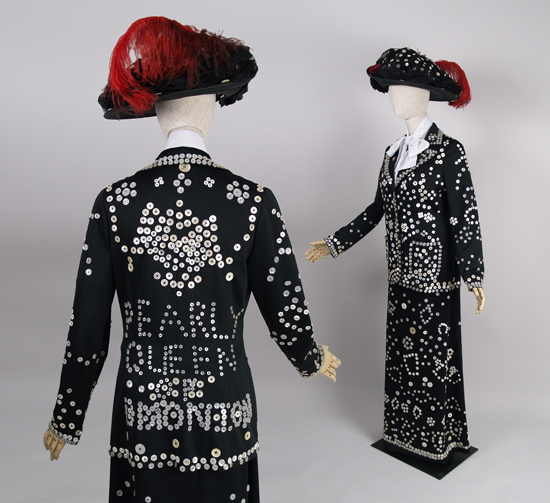
11
Black “Pearly Queen” Ensemble
Made and worn by Thelma Chissell (British) in Edmonton, Alberta, Canada, ca. 1970s
Polyester skirt suit and hat embellished with mother-of-pearl buttons and the words "Pearly Queen of Edmonton" Anne Lambert Clothing and Textiles Collection, 2012.4.6 a (jacket); b (skirt); 2012.4.10 (hat); 1991.20.82 (shoes); bow loaned by MacEwan University
Donated by June (née Chissell) and Michael Dickerson
The Pearly costumes tell a story of immigration and collective culture. This Edmonton Pearly family brought with them the values of the British Pearly community that aimed to help orphans and, eventually, collected for “the poor, deaf, dumb or blind.”[10] The tradition uses the power of dress to bring awareness to charitable causes, and continues today in London.

12
Green Cocktail Dress
Anne Klein & Co., New York City, USA, ca. 1950-65
Worn by Grace Keys in Edmonton, Alberta, Canada, ca. 1950-1965
Silk satin dress
Anne Lambert Clothing and Textiles Collection, 1998.33.37 a
Donated by Sheila Keicher
Worn with
Black Feathered Hat
Probably worn in Alberta, Canada, ca. 1965
Wool felt, iridescent feathers, grosgrain ribbon
Anne Lambert Clothing and Textiles Collection, 1979.11.14
Donated by Margaret K. Donald
Costume Jewelry
Probably worn in Alberta, Canada, ca. 1950s-1970s
Plastic and metal
Anne Lambert Clothing and Textiles Collection, 1991.20.52 a
Donated by Barbara Dorosh
Turquoise Pearlized Mules
Probably worn in Alberta, Canada, ca. 1965
Leather, plastic, and elastics
Anne Lambert Clothing and Textiles Collection, 1979.11.18 a, b
Donated by Margaret K. Donald
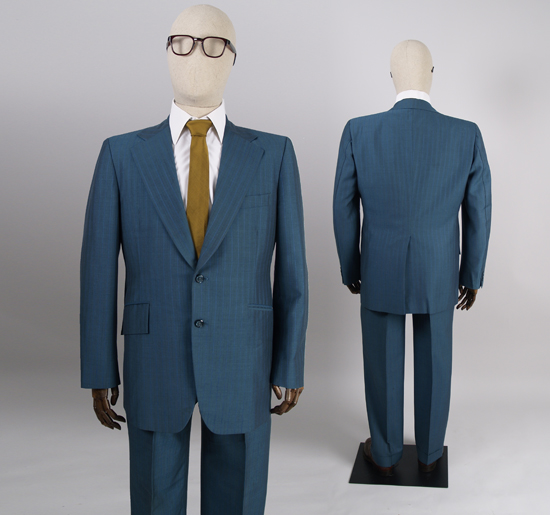
13
Teal Suit
Custom manufactured by Petone’s Clothes, Kowloon, Hong Kong, from measurements taken on the client in Toronto, Ontario, Canada, ca. 1960s-1970s
Worn by Harold Joseph Ashbridge Chambers (1902- 1990) in Toronto, Ontario, Canada, ca. 1960s-1970s
Loaned by Bill Sellers
Worn with
Brown Eyeglasses
Plastic, ca. 1960s
Anne Lambert Clothing and Textiles Collection, 1988.65.55
Donated by Johanna Lawrence
White Shirt
Loaned by MacEwan University
Gold Silk Tie
Probably worn in Alberta, Canada, ca. 1965
Anne Lambert Clothing and Textiles Collection, 2005.29.18
Donated by J. Reid Finlay
Brown Leather Brogue Shoes
Moy Kopf Shoes Manufacturer, Europe, 1940s
Leather and rubber
Anne Lambert Clothing and Textiles Collection, 2016.11.19 a, b
Donated by Jim Whittome
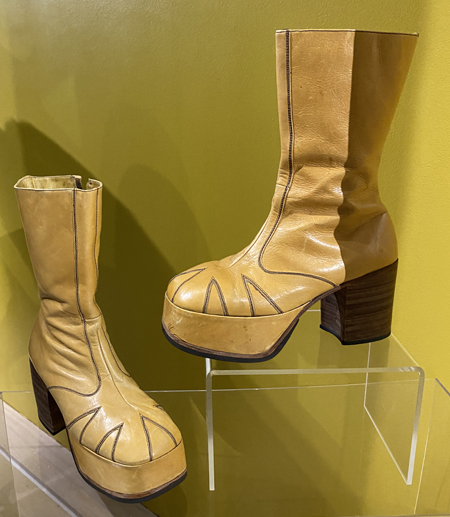
14
Yellow Platform Boots
Worn in Edmonton, Alberta, Canada, ca. 1975-1979
Leather, plastic and wood
Anne Lambert Clothing and Textiles Collection, 1994.27.1
Donated by Rob Maranchuk
Rob acquired these boots for approximately $60 at a shop during the 1976 opening of Kingsway Garden Mall in Edmonton. He wore them to the University of Alberta, to work as a soundman of a Rock band, and to clubs, bars, and movies.
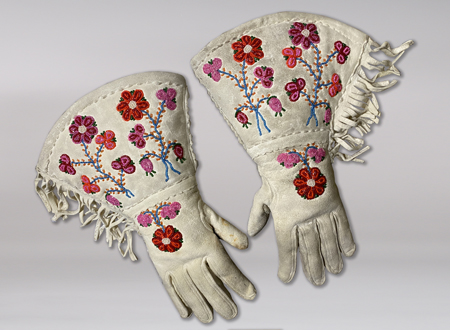
15
Multi-coloured First Nations Gauntlets
Unknown maker but assumed to be from a First Nation
Belonged to Vera Mabelle Campbell (née Gainer) (1915-1998), Edmonton, Alberta, Canada, ca. 1940-1990
Leather and glass beads
Anne Lambert Clothing and Textiles Collection, 1999.1.12 a, b
Donated by the Estate of Vera Campbell
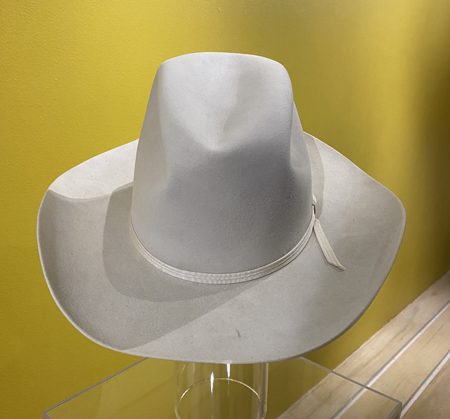
16
White Cowboy Hat
Macleod Brothers, Calgary, Alberta, Canada, ca. 1950s
Wool and leather
Anne Lambert Clothing and Textiles Collection, 2018.11.22
Bequest of Margaret Hess
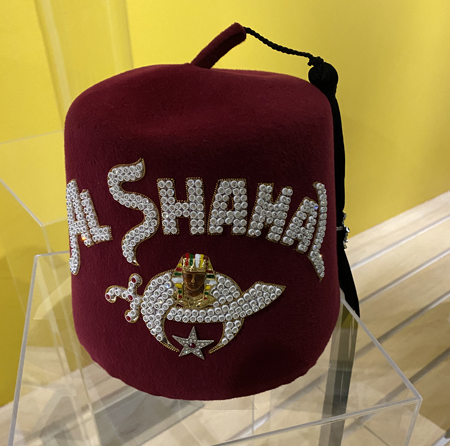
17
Shriners’ Fez Hat
Dominion Regalia, Toronto, Ontario, Canada, ca. 1950-1999
Wool, plastic, and rayon
FIC 2014.1.d
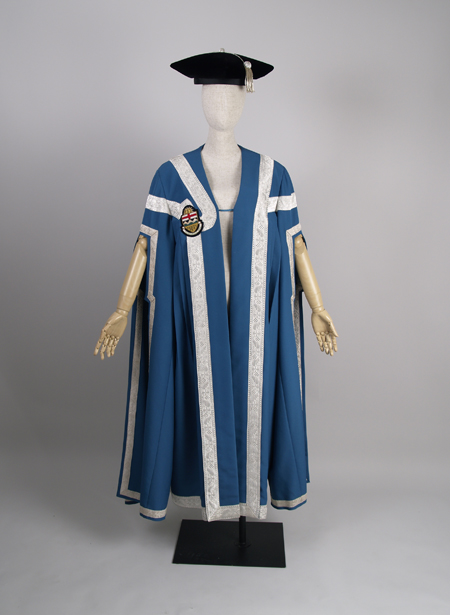
18
Teal University of Alberta Chancellor's Robe
Made by Harcourt & Sons Limited, robe makers and tailors in Toronto, Ontario, Canada, 1998
Worn by Lois Hole in Edmonton, Alberta, Canada, between 1998 and 2000
Polyester garment with silver-coloured “lace” trim
Anne Lambert Clothing and Textiles Collection, 2005.12.24
Bequest of Lois Hole
Worn with
Black Velvet Tam with Silver-coloured Tassel
Made by Harcourt & Sons Limited, robe makers and tailors in Toronto, Ontario, Canada, 1998
Worn by Lois Hole in Edmonton, Alberta, Canada, between 1998 and 2000
Rayon velvet and tassel
Anne Lambert Clothing and Textiles Collection, 2005.12.25
Bequest of Lois Hole

19
Red Shirt and Embroidered Blue Jeans
North American, ca. 1969 (shirt) and 1972 (pants)
Polyester-blend shirt with white top-stitching and cotton denim pants
Anne Lambert Clothing and Textiles Collection, 1994.27.2 c (shirt) and 2015.9.1 (pants)
Shirt donated by Anne Lambert and pants donated by Christopher Robing Allen
Worn with
Dark Blue and Maroon Two-toned Platform Shoes
Brazil, 1970s
Leather
Anne Lambert Clothing and Textiles Collection, 1994.28.50
Donated by Anne Lambert

20
Yellow “DRESS CODES ARE SEXIST RACIST CLASSIST” T-shirt
Gusonzsore, Sheridan, Wyoming, United States, 2021
Cotton polyester blend
Loaned by Anne Bissonnette
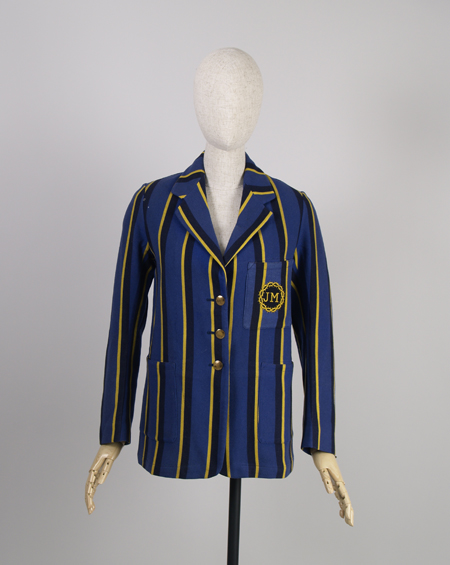
21
Blue and Yellow Striped School Blazer
Probably worn in Canada from the last quarter of the 20th century until 2013
Wool blazer with a patch pocket monogrammed in gold on dark blue with the letters “JM” in a circle
Anne Lambert Clothing and Textiles Collection, 2013.3.1. a
Donated by Jane Fitzpatrick
Anne Bissonnette, PhD
Emma Carr, BA
Josée Chartrand, MA
Qi Wang, BA
[1] The Canadian Encyclopedia, s.v. “North-West Mounted Police,” https://www.thecanadianencyclopedia.ca/en/article/north-west-mounted-police.
[2] John Peter Turner, The North-West Mounted Police, 1873-1893, Vol. 1 (King’s Printer, ON: 1950), 92.
[3] Ibid.
[4] Geraldine Craig, “Patterns of Change: Transitions in Hmong Textile Language," Hmong Studies Journal 11 (2010): 1.
[5] Mary Alice Chaney, “Hmong Baby Carriers in Minnesota: A Material Culture Study” (PhD Diss., University of Minnesota, 2011), 34. https://hdl-handle net.login.ezproxy.library.ualberta.ca/11299/115678.
[6] “Saint Lucian Traditional Wear,” Embassy of Saint Lucia to the Unites States of America, https://www.embassyofstlucia.org/culture-and-national-festivals.
[7] Ibid.
[8] London Pearly Kings and Queens Society, “Henry Croft 1862-1930),” https://www.pearlysociety.co.uk/henry-croft.
[9] Ibid. See also Pearlies of King Cross & St Pancreas, “Our History,” https://www.pearlies.org.uk/the-original-pearlies-history.
[10] London Pearly Kings and Queens Society, “Henry Croft 1862-1930),” https://www.pearlysociety.co.uk/henry-croft.
